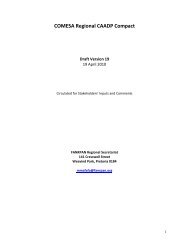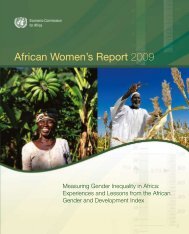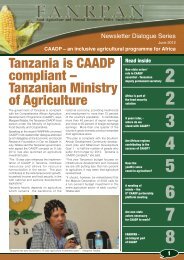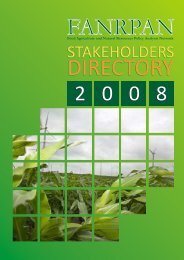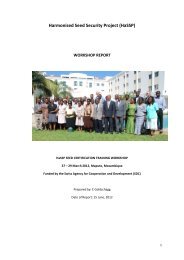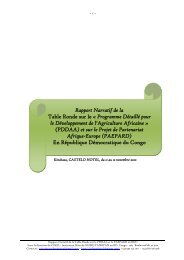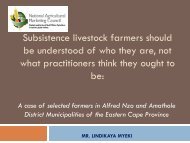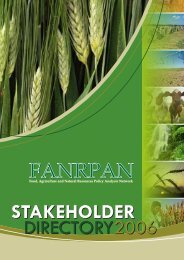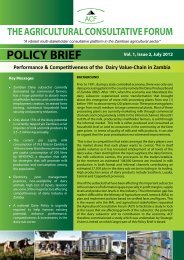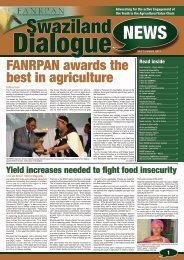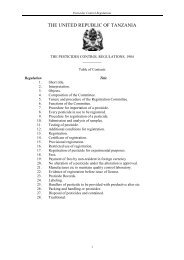Community-driven development decision tools for rural - IFAD
Community-driven development decision tools for rural - IFAD
Community-driven development decision tools for rural - IFAD
- No tags were found...
Create successful ePaper yourself
Turn your PDF publications into a flip-book with our unique Google optimized e-Paper software.
• In Segou, 41 per cent of the interviewees thought that members of the VDC are nominatedby the traditional authority, whereas the proportion in Kolokani is as low as 10 per cent.• Only 41 per cent in Segou know the functions of the VDC versus 91 per cent in Kolokany.A question posed to interviewees that gave very different results depending on the area wherethe project was being implemented, asked whether respondents felt that the interests of thecommunity were well represented at the local government levels (i.e. district or prefecture).Eighty-five percent of the interviewees in Segou respond “yes”, whereas in Kolokani only 31 percent are satisfied. In Guinea, two-thirds of the respondents (66 per cent) say that the interests ofthe community are well represented at the higher level, while the rest respond “no”, or “I donot know”.In Mali, the interviews clearly suggest a difference between Segou and Kolokany. In Segou,community members are willing to leave responsibility <strong>for</strong> <strong>decision</strong>s-making over thecommunity affairs to a VDC <strong>for</strong>med by members of the traditional authority, whereas inKolokany people follow the per<strong>for</strong>mance of their VDC much more closely, and are quite criticalof the current relationships with the higher level of the public administration. The situation inGuinea is somewhere in the middle between the two diverging positions identified in Mali.In Mauritania and Cape Verde, legislation enacted during the 1990s clarified the role of theCSOs of public utility with respect to supporting people’s initiatives at community level. Thisenhanced the policy supported by <strong>IFAD</strong>, which promoted a diversification of the institutionsinvolved in local <strong>development</strong> and poverty alleviation at community level. <strong>IFAD</strong> CDD projectsin these two countries were entrusted to CSOs of public utility, representing a significantinnovation in the local governance setting. In both countries, membership to the CSOs wasexpected to include a significant number of the people from the project area, with the aim ofhaving these people becoming the majority in due course.In the two areas investigated in Mauritania, all respondents to the opinion poll knew ofthe existence of the local CSO, with actual membership ranging from 61 per cent of thesample in Adrar to 86 per cent in Assaba. People in<strong>for</strong>med of the objectives and functions ofthe CSOs were 57 per cent and 61 per cent of the sample, respectively, in the two areas. InCape Verde, 75 per cent of the people interviewed knew of the <strong>Community</strong> DevelopmentAssociation (CDA) operating in their village or area. Forty-six per cent of the sample reportedthat they regularly attend regularly the general meetings of the CDA and another 13 per centirregularly. In addition, 70 per cent of the sample declares that women do attend thesemeeting and voice their opinions.In Cape Verde a smaller share of the respondents (34 per cent) declared to be well in<strong>for</strong>medabout the functions and responsibilities of the CDA and about the way the directors of theCDA were nominated. This low result may be the consequence of the fact that only around 30per cent of the random sample were people targeted by the <strong>IFAD</strong> project and members of theCDA that benefited from the project intervention.With respect to questions regarding community based organizations (CBOs) dedicated toproviding private goods <strong>for</strong> the benefit of their members, the main results of the study aregiven in the following box. In Mauritania, the most important CBOs operating in the oases arethe MICOs (local microfinance institutions funded by the <strong>IFAD</strong> project) with 75 per cent ofthe interviewees being a member and 57 per cent of the sample in the Adrar and 61 per cent inthe Assaba being adequately in<strong>for</strong>med of the objectives of the MICOs. Other CBOs (mostlyproduction or service cooperatives, many women’s cooperatives) are also present, but sincethey cannot qualify <strong>for</strong> legal registration, they operate through the local CDA. Other CBOsconcerned with the maintenance of irrigation infrastructure and various water sources alsotend to overlap with the CDAs, in the sense that it is the CDA that maintains the infrastructureand raises the revenue necessary <strong>for</strong> maintenance from the users.94



